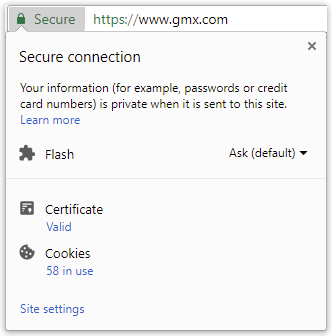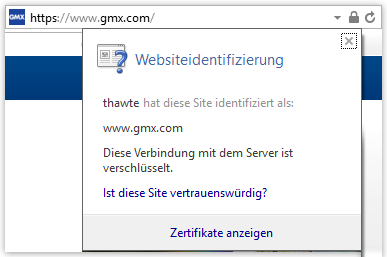Navigation auf-/zuklappen
Verifying a Certificate
Your browser verifies whether a certificate is real and your connection is secure for you. First, ensure that you are connected with GMX via SSL or TLS. This is indicated to you by the protocol "https" in your browser address bar.
How to Verify a Certificate in Mozilla Firefox
- To the left of the address bar, you can see a lock when the connection is secure. When the connection is not secured, you can see a globe.
- Click the lock.
-
If the following information is displayed, you can assume that the connection
is secure and log in:
- "You are connected to (or navigator.gmx.com)"
- "Verified by: T-Systems International GmbH"
- "The connection to
this website is secure."

How to Verify a Certificate in Google Chrome
- To the left of the address bar, you can see a lock when the connection is secure. When the connection is not secured, you can see an empty sheet of paper.
- Click the lock.
- Click Connection.
-
If the following information is displayed, you can assume that the connection
is secure and log in:
- "The identity of gmx.com (or navigator.gmx.com) has been verified"
- "The identity of this
website has been verified by TeleSec ServerPass DE-2 but does not have
public audit records."

How to Verify a Certificate in Internet Explorer
- To the right of the address bar, you can see a lock when the connection is secure. When the connection is not secured, this icon is missing.
- Click the lock.
-
If the following information is displayed, you can assume that the connection is secure and log in:
- "Deutsche Telekom Root CA 2 has identified this site as: gmx.com (or navigator.gmx.com)"
- "This connection to the server is encrypted.">

Was this article helpful?